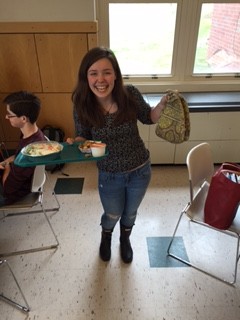School Food with Integrity

May 9, 2016
Everyday, a student in any high school is provided with a school lunch. This lunch is either purchased at school or brought from home. When it comes to buying lunches from school cafeterias, one frequently asked question is: Are school lunches actually healthy for students?
Most people who eat the lunches provided by the school would say they aren’t the healthiest in their opinion. On the other hand, many studies show school lunches fit the exact criteria they are required to follow in providing kids with a healthy meal. After asking one of the lunch ladies at Ipswich High School if she believes schools provide the healthiest choice possible in school lunches, she quickly responded by saying, “They do. Although they may not be tasty, government regulations require us to provide a healthy meal.” Nowadays, schools are required to provide the healthiest meals for the students so they can have their energy restored to get through the rest of the school day and their after school activities.
School meals are required to meet the Dietary Guidelines for Americans which outlines the different sized portions for each food category. Each school is required to provide the students with fruits, vegetables, grains, meat alternative, and milk. For the grain component, the cooks need to supply at least 8 grams of whole wheat. Meat is also provided everyday to give students protien. There needs to be at least two different milk options to choose from, such as fat-free (flavored or unflavored), low-fat (unflavored), or fat-free or low-fat (lactose-reduced or lactose-free). On Top of that, there are weekly requirements for the calorie intake per grade. For instance, high school students, grades 9 to 12, are provided with roughly 750-800 calories per lunch. The students in grades 6 to 8 only need to eat at least 600-700 calories per meal. All these changes and requirements for school food were put into effect on July 1st, 2012.
When Brooke Fitzgerald, a senior at Ipswich High School, was asked if she had a choice between school lunch or bringing her own lunch, she replied, “I would definitely bring my own because I can pack all my favorite foods.” Just like the lunch lady said, the food isn’t always the tastiest because they are trying to make it healthy, such as using gluten free and wheat bread rather than white bread. Another student, Sofia Gadbois, stated “They [school cafeterias] offer healthy options as sides, but I feel like the main course is usually not very healthy because, for example, right now the main course is a bacon cheeseburger and bacon cheeseburgers are not very healthy.” Other people added in how they also serve pizza and calzones. You could say those options sound appealing but not healthy.
Most students are more interested in the taste of their food rather than the overall health benefits. In summary, cafeterias try to balance providing different types of foods for everyone to eat and hopefully enjoy while still making it appealing. Maybe one day they can incorporate both good tasting and healthy foods into one meal!
